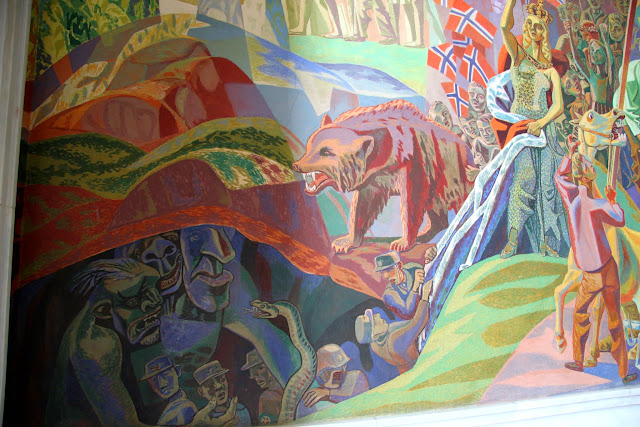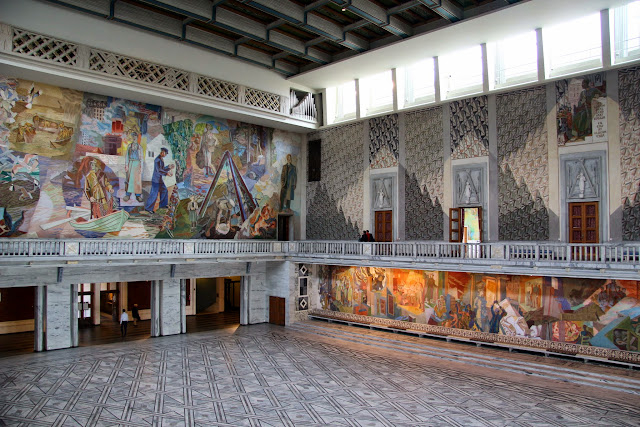Scandinavia has a good track record for building impressive city halls. Stockholm City Hall (Stadshuset) is one of my favorite buildings in the world. Köpenhamn's city hall isn't bad either. While Stockholm's city hall reflects Sweden's national romantic movement, Oslo's city hall was completed after World War II and pulls on both the romantic ornate style and some of the updated thoughts that came through between 1930 and 1950 (Construction and the design was actually started in the 1930s, but was paused due to the outbreak of the war).
While the exterior is impressive in itself, the interior is fascinating. What you see on the walls is the history of Norway emerging as a national identity and what it endured during the war years. Norway was occupied by Germany in order to provide bases for u-boats, to provide a secure route for Swedish iron from Narvik to Germany, and to preempt any invasion by Britian that would cut off iron from Germany (which was seriously considered). During the war years, a puppet government led by Vidkun Quisling (Quisling still retains an inherently negative tone for betrayal in Norway) and his native fascist party (the "National Gathering") was put into power. In reality, the reichskommissar appointed by Hitler held power.
Norway largely resisted Germany during the war years. The resistance in Norway is credited with hindering Hitler's nuclear ambitions by sabotaging a shipment of heavy water (used to control fission) and smaller acts such as ensuring that German submariners had gastrointestinal distress while at sea. Many Norwegians suffered during the war at the hands of both the Nazis and Norwegian collaborators. The experience was etched into the national psyche after the war. The story is woven into the stories told in the interior art of the city hall.
 |
| German soldiers hide from the Norwegian people in a cave, along with a troll and snake. |
 |
| German conspirators depicted in the main hall of Rådhuset in Oslo |
One of the walls is covered with a depiction of Norwegian industry and work, while the other portrays civil society.
At one end of the hall is also the mural below. The mural focuses on emergence of socialism in Norway, the reasons that caused citizens to take action, and the vision for the future. On the left, is the depiction of a society still rooted in aristocracy, patronage, and the ills of the poor being left behind. In the middle, there is the emergence of labor and socialism. Norway for much of its existence has been a society based on fishing and subsistence farming. Hardly industries that generated immense wealth. It is a hard place to live and there were no vast riches to be had (at least until oil was discovered).
The signs in the middle have such radical demands such as the eight hour work days, a Norwegian social security system, vacation for workers, and voting rights for woman. It is worth noting that these things, both in Norway and in other places like the United States, were the result of the labor movement and that these were not free. In the background, you can see men on horses beating the demonstrators. This was not a scene unique to Norway.
The future? Home, health, prosperity, and security in old age for all.
Another especially powerful room follows the pattern of presenting two contrasting themes is the room below. Visually, the dimensions of the create a sense of towering and intimacy that is not found elsewhere in the areas I visited. The single thin window provides natural light, but accents the height of the room.
On each wall are two different stories of Norwegian society: The city and the country.
On one wall, we have Oslo during the winter. It is an urban cityscape that is both an idealized city, but also hides a variety of sub-stories in the imagery. The one that grabbed me is the view into the window of one of the apartments behind the men with skis. There is a woman and man who very obviously have just been fighting. She has her face in her hands while he looks out the window with his back to her. It's a very human scene and the choice to include it is interesting to me: Here, in an official building, we have an example of human fallibility and pain in a mural that otherwise presents a rosy picture of city life. The contrast makes it noteworthy, in my opinion.
On the other wall, we have the country side. The mural highlights the workers of the land, natural beauty, and an agrarian ideal. The expression of the cow below was my favorite part, although there was also some reference at the top that bugs in the countryside can be... large. One of them is depicted as being stabbed with a very large stick.
That's it for Oslo's City Hall (Rådhuset). Next Stop? How about a walk around town and some lunch?















No comments:
Post a Comment